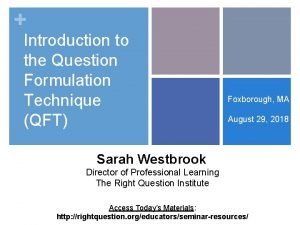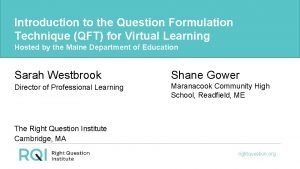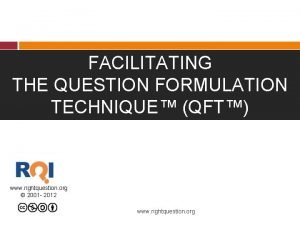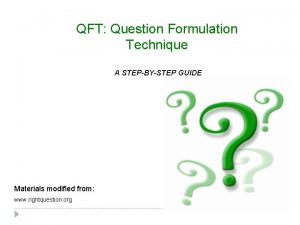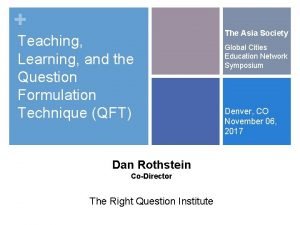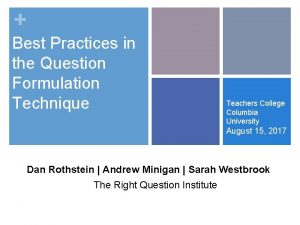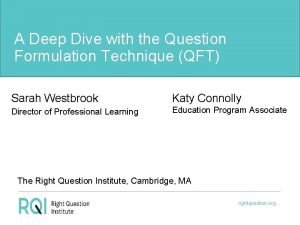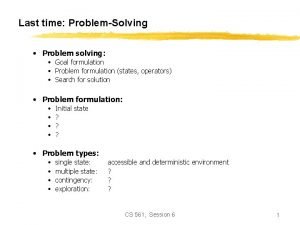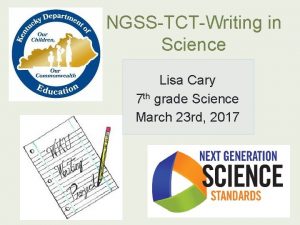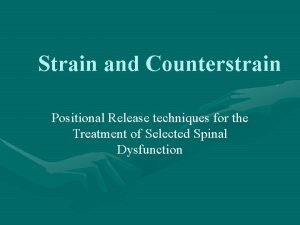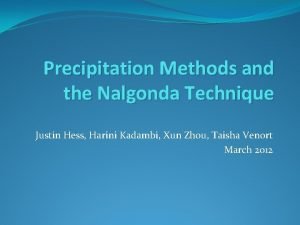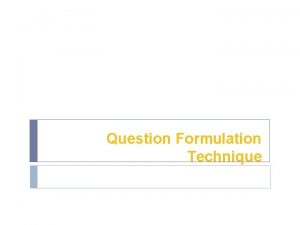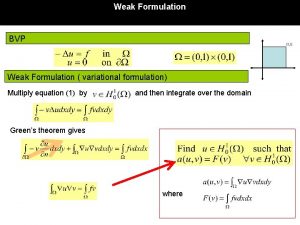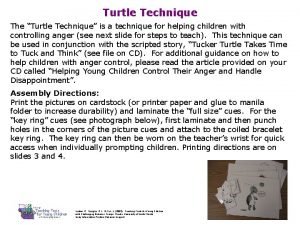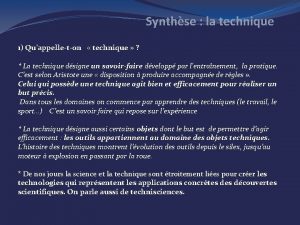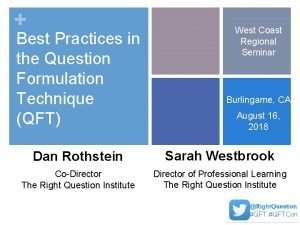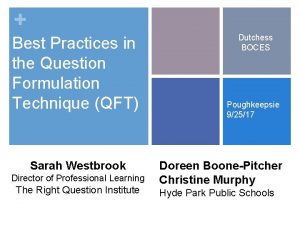Question Formulation Technique Protocol Steps 1 Design a













- Slides: 13

Question Formulation Technique Protocol Steps

1. Design a question focus 2 nd Grade – Weather Events Julie Grimm, Teacher � Teacher selected topics: � Weather events: floods, tornadoes, hurricanes… (article not specific)

1. Design a question focus 6 th Grade – Ancient Greece Calvin Lange & Kathy Mc. Hugh � Students generated topics: � - Research appetizer: students explored resources and each generated his/her own list of topics � - Shared out as class to create list for each period � - Teachers created 6 broad topics with subtopics

2. Students produce questions Julie Grimm � Posted and explained QFT four rules: � 1. Ask as many questions as you can. � 2. Do not stop to judge, discuss, edit, or answer any question. � 3. Write down every question exactly as it was asked. (Who was writing down questions? ) � 4. Change any statements into questions. � Class Discussion: What might be difficult about following rules? � - During activity, teacher remains “neutral facilitator” by urging students to keep writing more questions, but not helping to write questions or evaluate them.

2. Students produce questions Calvin Lange & Kathy Mc. Hugh � Posted and explained customized QFT rules: � 1. Each person picks a pen and area on chart paper. � 2. Everyone works at the same time writing down his/her questions. Write questions, not statements. � 3. Do not stop to judge, discuss, edit, or answer any question. � 4. Keep going! Each group generates as many questions as possible. � � - During activity, teachers remain “neutral facilitators” by urging students to keep writing more questions, but not helping to write questions or evaluate them.

3. Open-ended & closed-ended questions Julie Grimm � Presented simple explanation of difference between open-end and closed-ended questions: � - Discussion of how the type of question drives research. � - Students converted some closed-ended questions to open-ended. Converted some open-ended to closed-ended. � - Not yet choosing research questions � - Teacher not judging questions � - Students guided towards qualities that make the best research questions

3. Open-ended & closed-ended questions Calvin & Kathy � Presented simple explanation of difference between open-end and closed-ended questions: � - Discussion of how the type of question drives research. - Students sat in topic groups. � - Taking turns, each student chose any question from chart paper, identified type of question, converted all closed-ended to open-ended. Converted some open-ended to closed-ended. � - Not yet choosing research questions � - Teacher not judging questions � - Students guided towards qualities that make the best research questions

4. Students prioritize questions Julie Grimm � Purpose - create questions for further research: � Instructions to groups: Choose three openended questions you want to use in your research. Students determined a prioritized order to answer the questions.

4. Students prioritize questions Calvin & Kathy � Purpose - create questions for further research: � Instructions to individuals: Choose three open -ended questions you want to use in your research related to the topic you choose. May use questions that you or someone else wrote. (Order of questions not important)

5. Teacher & students discuss next steps for using questions Julie Grimm � How will the students use the questions? � Use research notes to write books, create models, and make posters. (Not explained how work was divided).

5. Teacher & students discuss next steps for using the questions Calvin & Kathy � How will the students use the questions? � May drop question(s) or add new ones if research takes you in a different direction. � Notes will be used to write an essay. � Also take notes on related interesting information to be used in essay introduction.

6. Students reflect Julie Grimm � Metacognitive Exercise � Teacher asked class: “What did you learn? ” and “How did you learn that? ”

6. Students reflect Calvin & Kathy
 Question formulation technique pdf
Question formulation technique pdf Qft questioning
Qft questioning Question formulation technique worksheet
Question formulation technique worksheet Question formulation technique example
Question formulation technique example Question formulation technique worksheet
Question formulation technique worksheet Qft questioning
Qft questioning Question formulation technique examples
Question formulation technique examples Question formulation technique example
Question formulation technique example Why problem formulation follow goal formulation
Why problem formulation follow goal formulation Level 3 questions
Level 3 questions Research design formulation
Research design formulation Student work analysis protocol steps
Student work analysis protocol steps Strain counterstrain
Strain counterstrain Alum precipitate
Alum precipitate
